Paramètres
Cet article concerne AdGuard pour Android, un bloqueur de publicités multifonctionnel qui protège votre appareil au niveau du système. Pour voir comment ça fonctionne, téléchargez l'application AdGuard
L'onglet Paramètres est accessible en appuyant sur l'icône la plus à droite en bas de l'écran. Cette section contient divers paramètres, des informations sur votre application, votre licence et abonnement, ainsi que diverses ressources d'assistance.
Général
Cette section vous aide à gérer l'apparence et le comportement de l'application : vous pouvez définir le thème de couleur, la langue, gérer les notifications, et plus encore. Si vous souhaitez aider l'équipe AdGuard à détecter les plantages et à étudier l'ergonomie, vous pouvez activer Signaler les plantages automatiquement et Envoyer des données techniques et d'interaction.
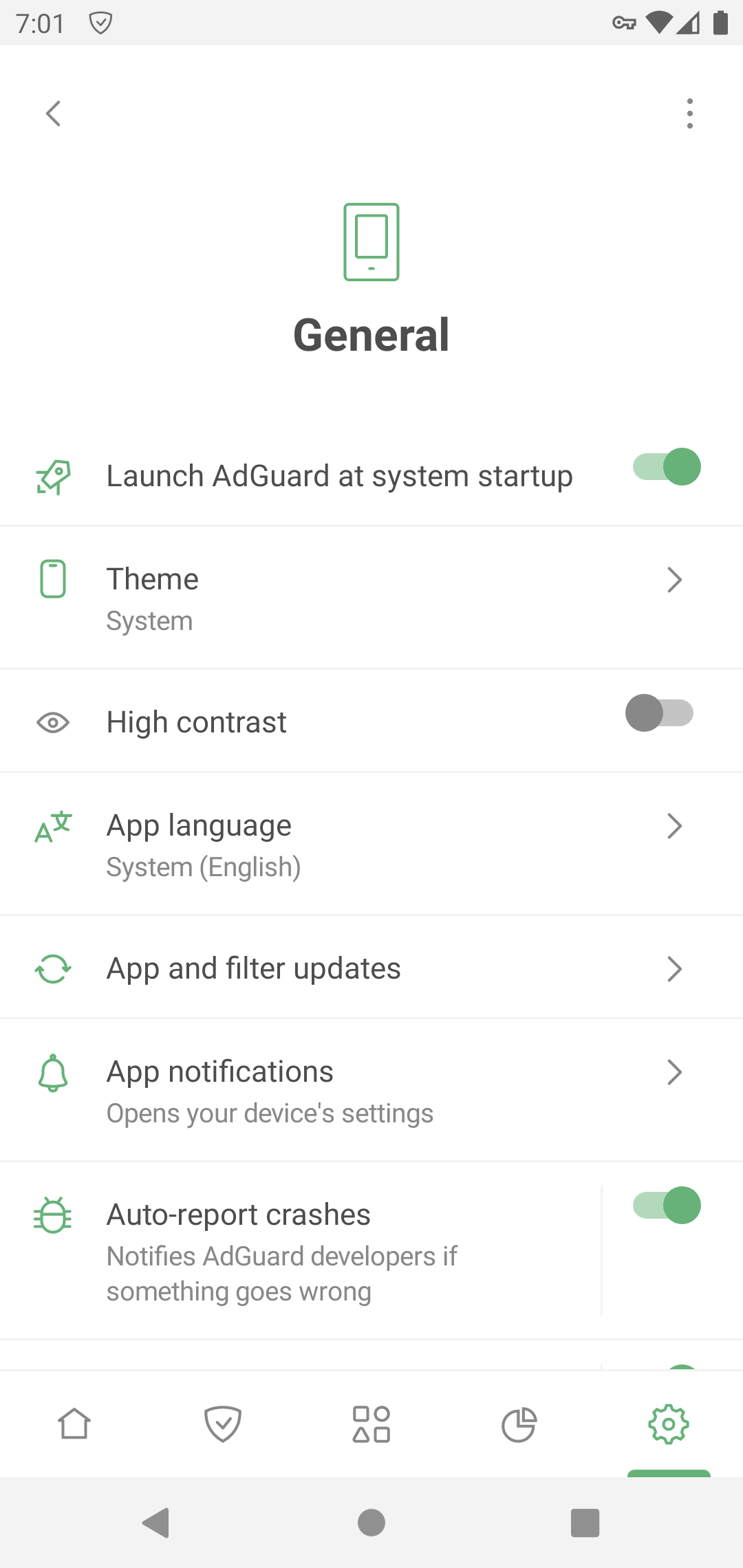
Dans Mises à jour de l'application et des filtres, vous pouvez configurer les mises à jour automatiques des filtres et choisir un canal de mise à jour de l'application. Choisissez Version pour plus de stabilité et Bêta ou Nightly pour un accès anticipé aux nouvelles fonctionnalités.
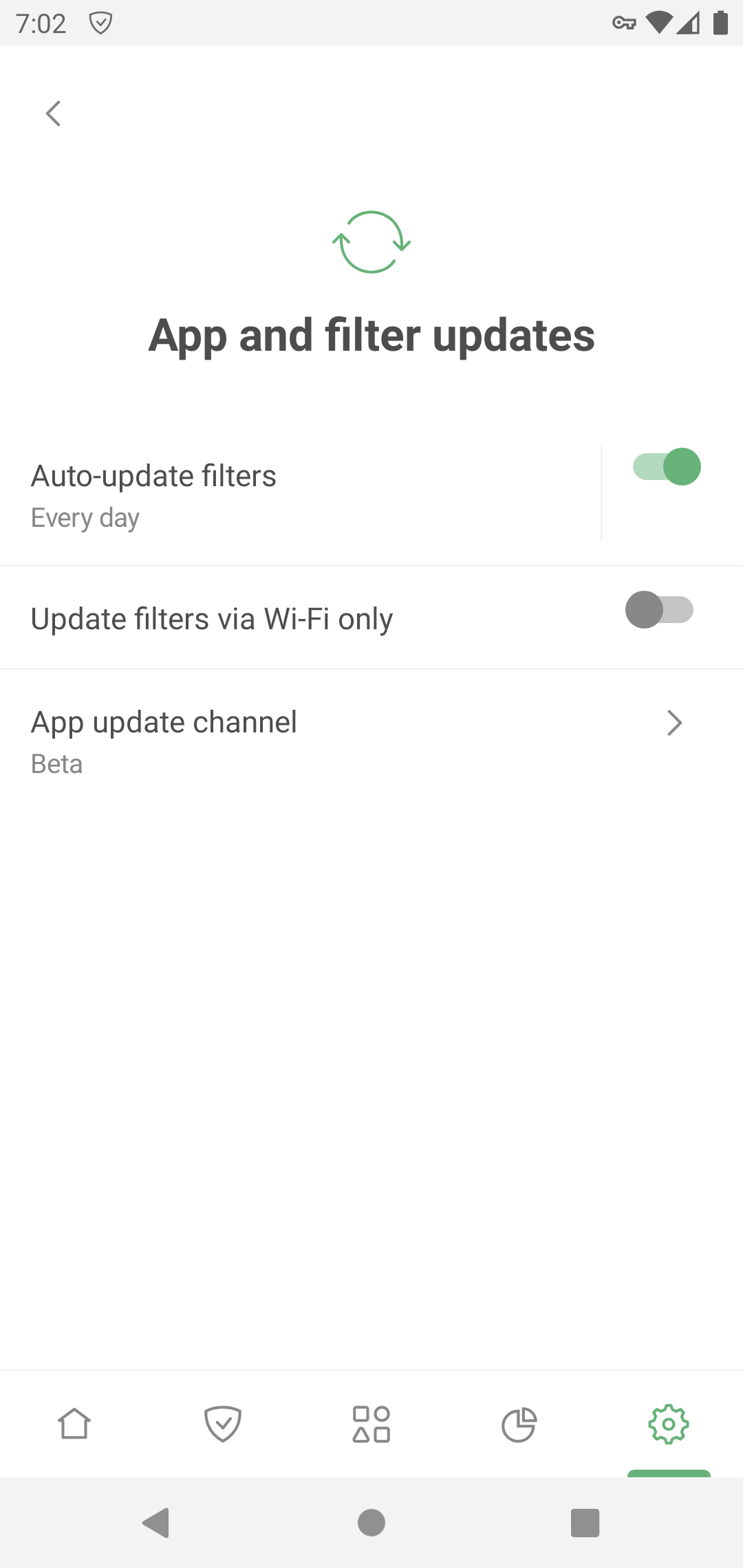
Paramètres avancés
L'automatisation vous permet de gérer AdGuard via des applications du type Tasker.
Watchdog aide à protéger AdGuard contre la désactivation par le système (en savoir plus sur le mode d'économie de batterie d'Android). La valeur que vous saisissez sera l'intervalle en secondes entre les vérifications de watchdog.
Le Niveau de journalisation définit les données sur le fonctionnement de l'application qui doivent être enregistrées. Par défaut, l'application enregistre les événements. Le niveau Debug enregistre plus d'événements — activez-le si l'équipe d'AdGuard le demande pour l'aider à mieux comprendre le problème. En savoir plus sur la collecte et l'envoi de journaux
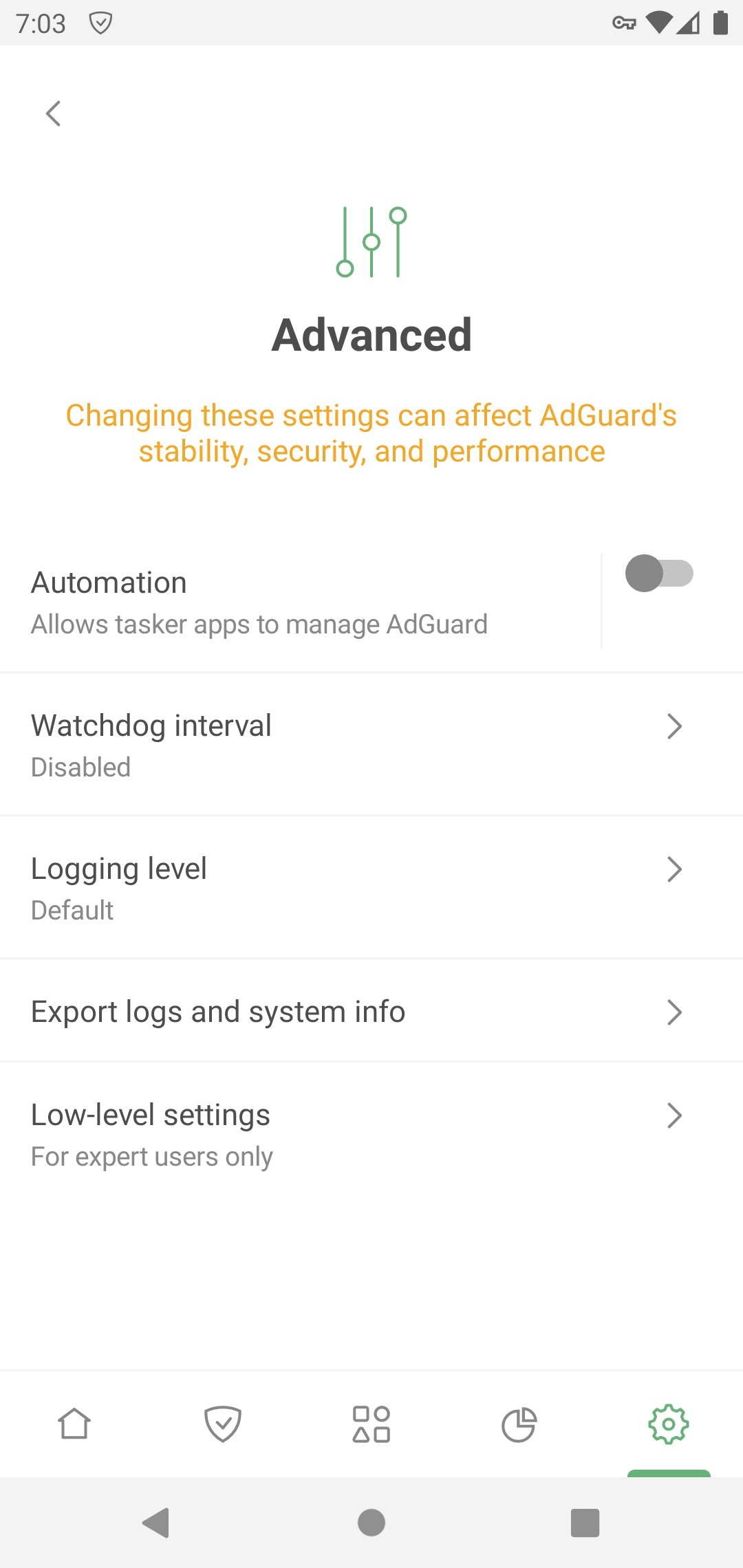
La section Paramètres de bas niveau est destinée aux utilisateurs experts. En savoir plus sur les paramètres de bas niveau
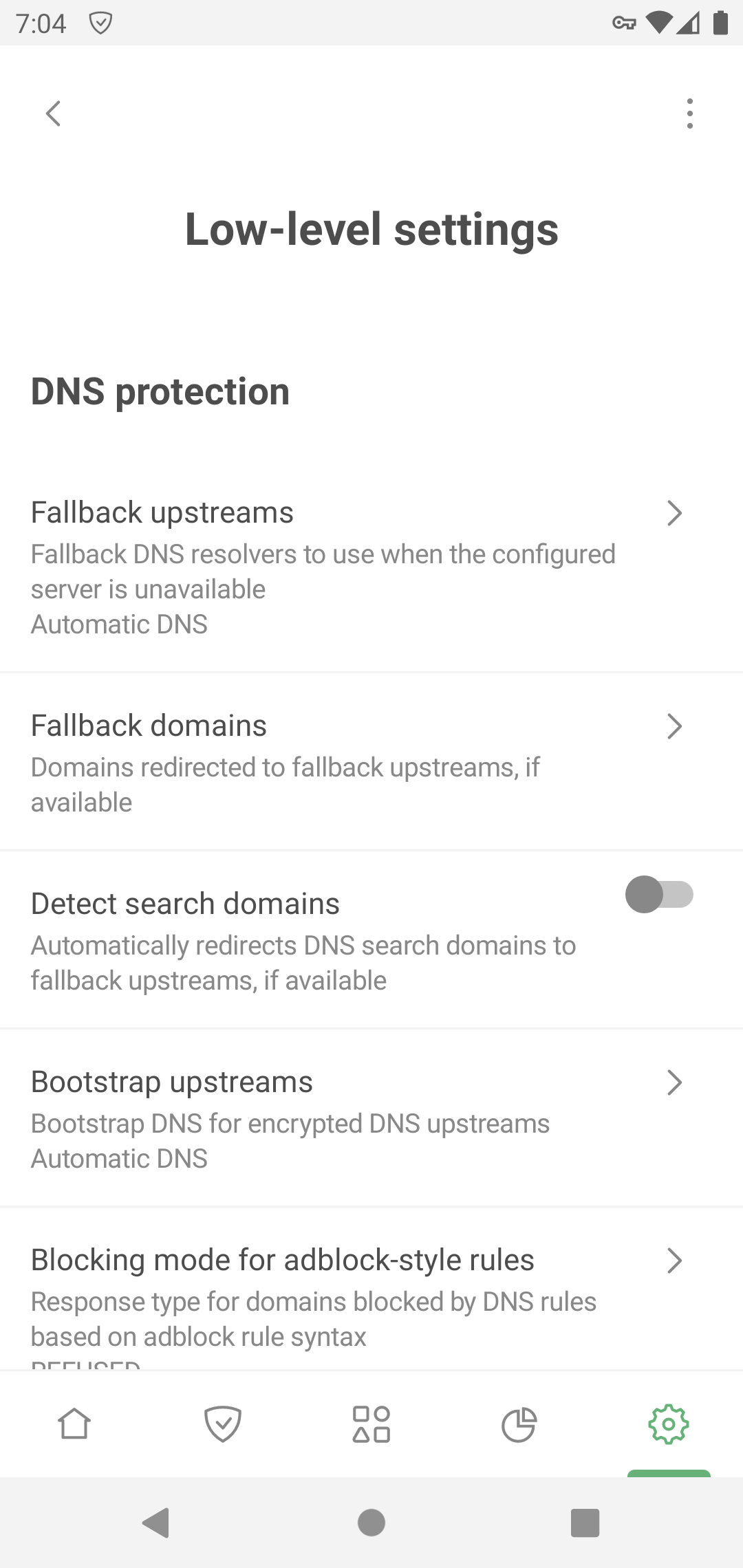
Filtrage
Cette section vous permet de gérer les paramètres de filtrage HTTPS, les filtres, les scripts utilisateur et de configurer un serveur proxy.
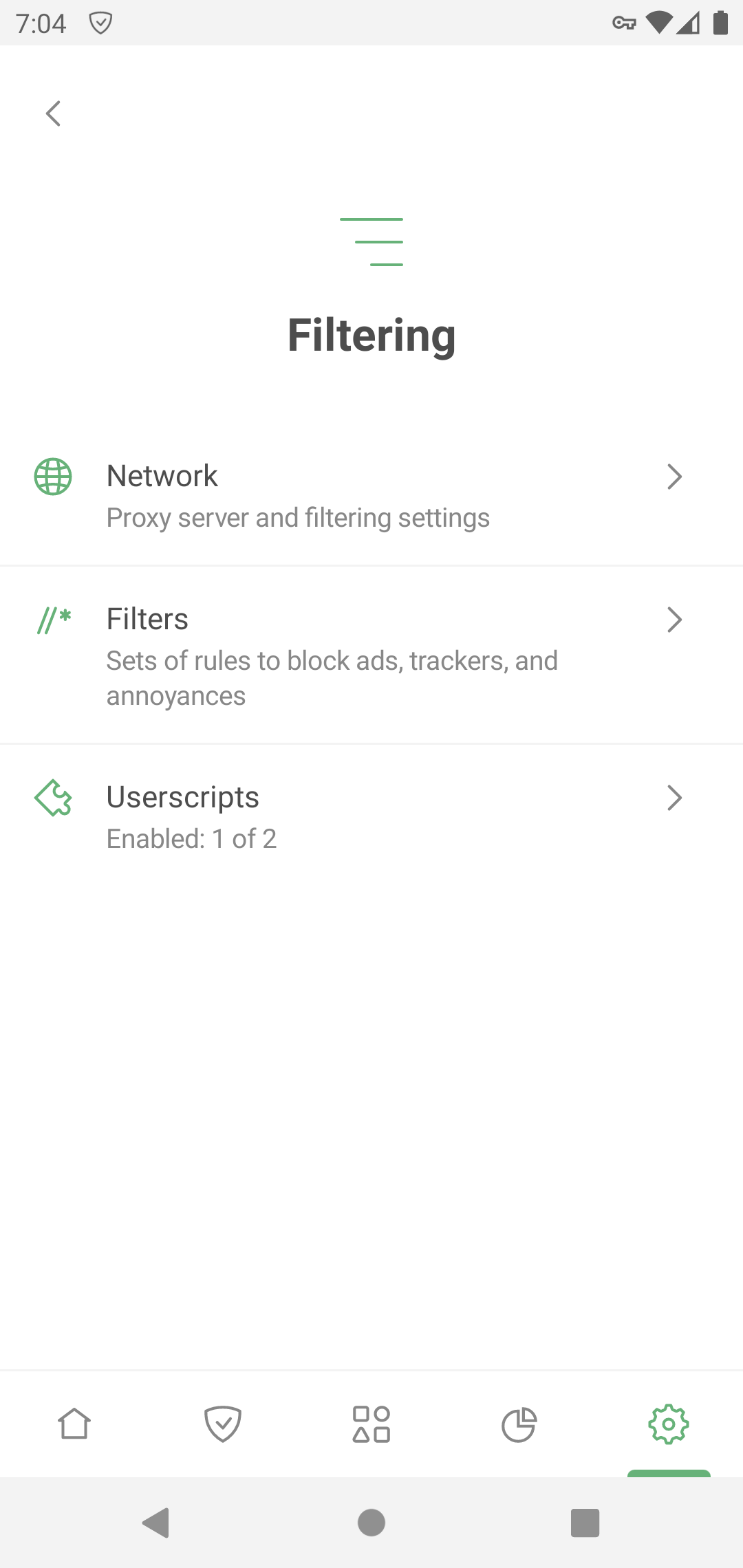
Filtres
AdGuard bloque les publicités, les traqueurs et les nuisances en appliquant des règles issues de ses filtres. La plupart des fonctionnalités de la section Protection sont alimentées par les filtres AdGuard. Si vous activez la Protection de base, le filtre de base AdGuard et le filtre des publicités mobiles AdGuard seront activés automatiquement. Et vice versa : si vous désactivez les deux filtres, la Protection de base sera également désactivée.
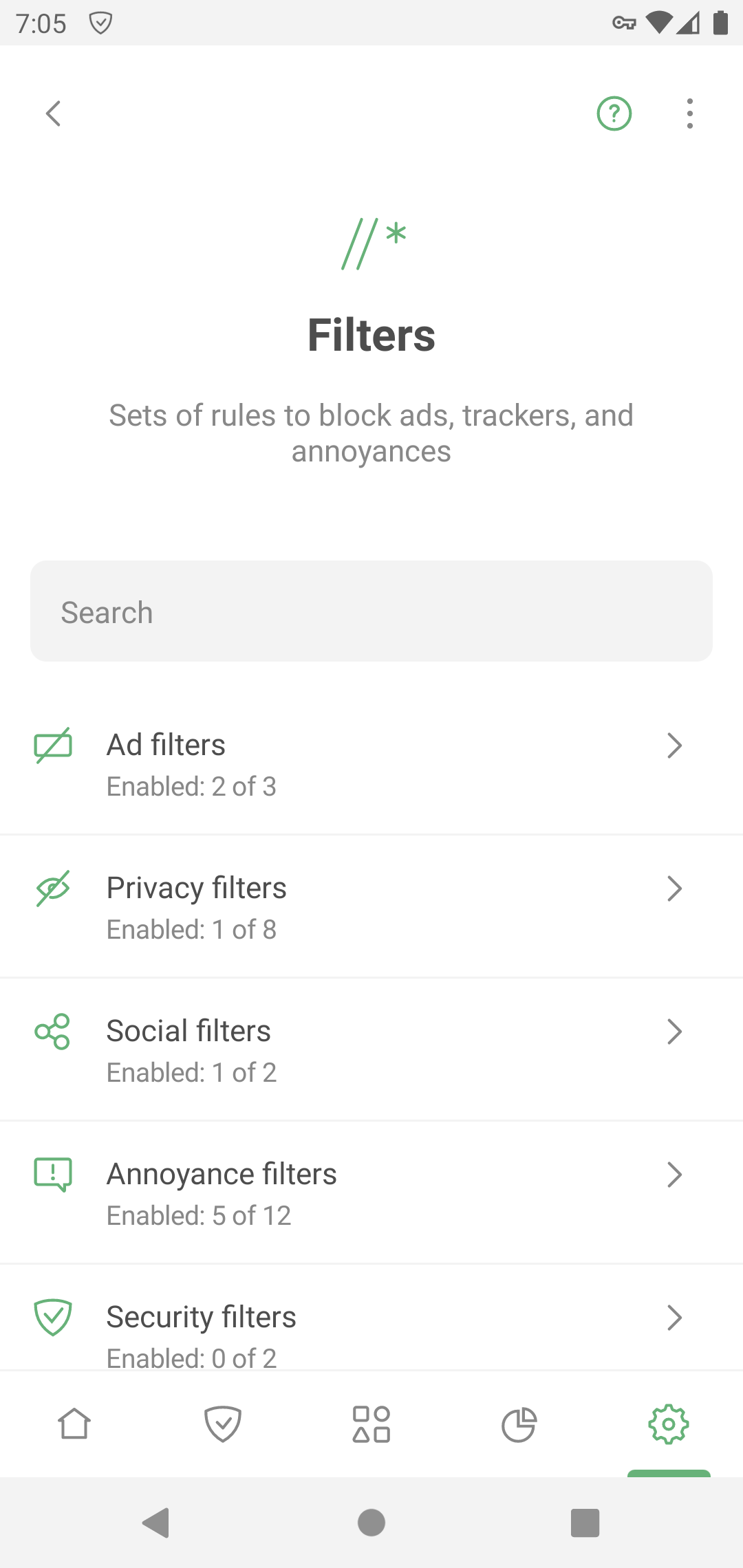
Les filtres activés par défaut sont suffisants pour le bon fonctionnement d'AdGuard. Cependant, si vous souhaitez personnaliser le blocage des publicités, vous pouvez utiliser d'autres filtres AdGuard ou de tiers. Pour ce faire, sélectionnez une catégorie et activez les filtres souhaités. Pour ajouter un filtre personnalisé, appuyez sur Filtres personnalisés → Ajouter un filtre personnalisé et saisissez son URL ou son chemin de fichier.
Si vous activez trop de filtres, certains sites web peuvent ne pas fonctionner correctement.
En savoir plus sur les filtres
Scripts utilisateur
Extensions allow you to add userscripts and userstyles.
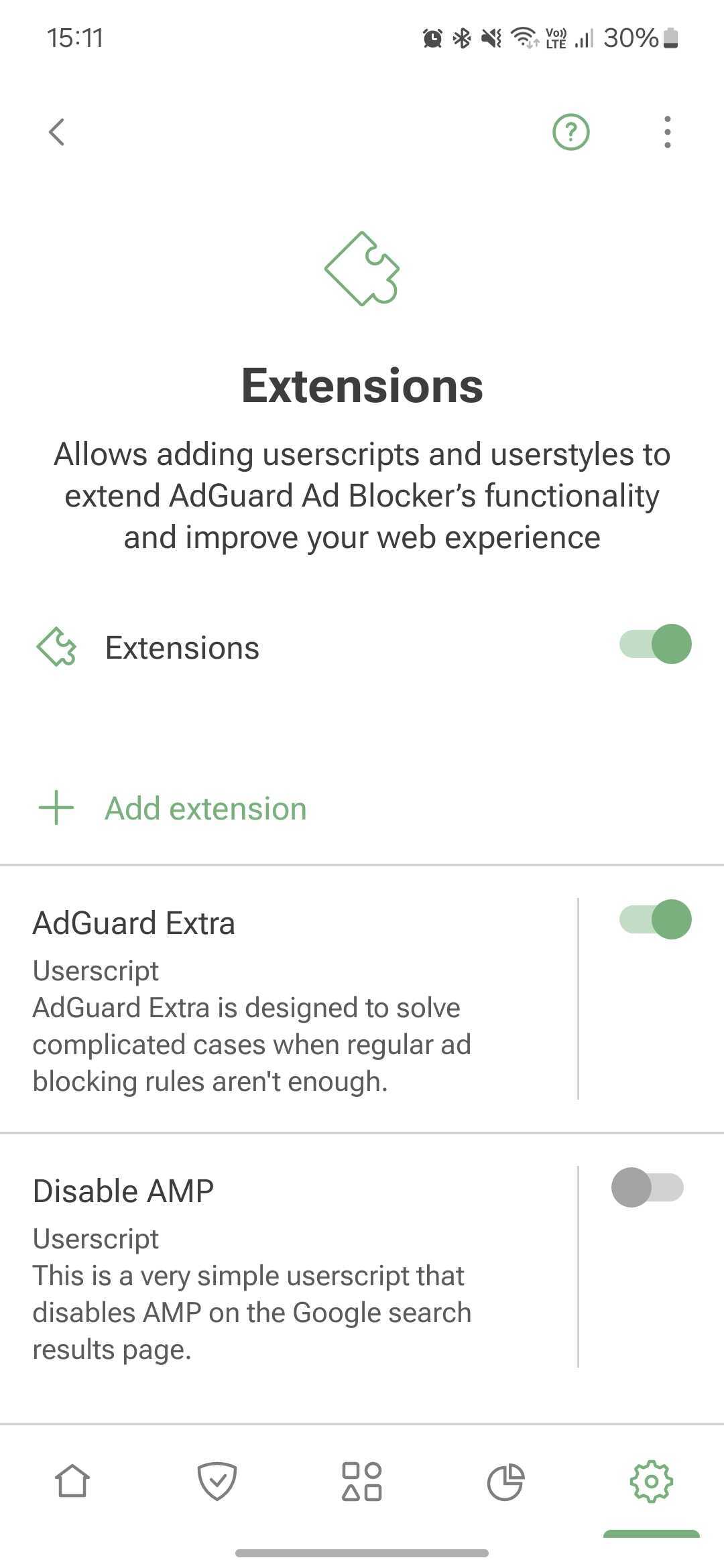
Les scripts utilisateur sont des mini-programmes écrits en JavaScript qui étendent la fonctionnalité d'un ou plusieurs sites web. Pour installer un script utilisateur, vous avez besoin d'un gestionnaire de scripts utilisateur. AdGuard possède cette fonctionnalité et vous permet d'ajouter des scripts utilisateur via une URL ou à partir d'un fichier.
Userstyles are like userscripts that allow you to change how web pages look in the browser without modifying their content. They work by adding CSS styles to the website’s existing styles. For example, if you want a dark theme on a website that doesn’t offer one, you can use a userstyle to do it.
To add a userstyle, go to Settings → Filtering → Extensions→ Add extension → Import from file or URL. You can find ready-made user styles online.
To create your own style, tap Add extension → Create userstyle.
AdGuard Extra
AdGuard Extra est un script utilisateur personnalisé qui bloque les publicités complexes et les mécanismes qui réinjectent des publicités dans les sites web.
Désactiver AMP
Désactiver AMP est un script utilisateur qui désactive les Pages mobiles accélérées dans les résultats de recherche Google.
Réseau
Filtrage HTTPS
Pour bloquer les publicités et traqueurs sur la plupart des sites web et dans la plupart des applications, AdGuard doit filtrer leur trafic HTTPS. En savoir plus sur le filtrage HTTPS
Certificats de sécurité
Pour gérer le trafic chiffré, AdGuard installe son certificat CA sur votre appareil. C'est sûr : le trafic est filtré localement et AdGuard vérifie la sécurité de la connexion.
Sur les anciennes versions d'Android, le certificat est installé automatiquement. Sur Android 11 et versions ultérieures, vous devez l'installer manuellement. Instructions d'installation
Le certificat CA dans le stockage utilisateur est suffisant pour filtrer le trafic HTTPS dans les navigateurs et certaines applications. Cependant, certaines applications n'acceptent que les certificats provenant du stockage système. Pour filtrer le trafic HTTPS dans celles-ci, vous devez installer le certificat CA d'AdGuard dans le stockage système. Instructions
Applications filtrées en HTTPS
Cette section contient la liste des applications pour lesquelles AdGuard filtre le trafic HTTPS. Veuillez noter que ce paramètre peut être appliqué à toutes les applications uniquement si vous avez des certificats CA dans le stockage d'utilisateur et dans le stockage système.
Sites web filtrés en HTTPS
Ce paramètre vous permet de gérer les sites web pour lesquels AdGuard doit filtrer le trafic HTTPS.
Le filtrage HTTPS permet à AdGuard de filtrer le contenu des requêtes et des réponses, mais nous ne collectons ni ne stockons jamais ces données. Cependant, pour renforcer la sécurité, nous excluons les sites contenant des informations potentiellement sensibles du filtrage HTTPS.
Vous pouvez également ajouter des sites que vous considérez nécessaires aux exclusions en sélectionnant l'un des modes :
- Exclure certains sites du filtrage HTTPS
- Filtrer le trafic HTTPS uniquement sur les sites ajoutés aux exclusions
Par défaut, nous ne filtrons également pas les sites Web dotés de certificats de validation étendue (EV), tels que les sites financiers. Si nécessaire, vous pouvez activer l'option Filtrer les sites web avec des certificats EV.
Proxy
Vous pouvez configurer AdGuard pour qu'il redirige tout le trafic de votre appareil via votre serveur proxy. Comment configurer un proxy sortant
Dans cette section, vous pouvez également configurer un VPN tiers pour fonctionner avec AdGuard, si votre fournisseur VPN le permet.
Sous Applications fonctionnant via un proxy, vous pouvez sélectionner des applications qui achemineront leur trafic via votre proxy spécifié. Si vous avez activé l'Intégration avec AdGuard VPN, ce paramètre joue le rôle d'exclusions d'applications d'AdGuard VPN : il vous permet de spécifier les applications à acheminer via le tunnel AdGuard VPN.
Mode de routage
Cette section vous permet de choisir la méthode de filtrage du trafic.
- VPN local filtre le trafic à travers un VPN créé localement. C'est le mode le plus fiable. En raison des restrictions d'Android, c'est également la seule méthode de filtrage de trafic disponible sur les appareils non rootés.
Le mode VPN local ne permet pas d'utiliser AdGuard simultanément avec d'autres VPN. Pour utiliser un autre VPN avec AdGuard, vous devez le reconfigurer pour fonctionner en mode proxy et configurer un proxy sortant dans AdGuard. Pour AdGuard VPN, cela se fait automatiquement à l'aide du Mode intégré.
- Le proxy automatique est une méthode alternative de routage du trafic qui ne nécessite pas l'utilisation d'un VPN. L’un des avantages majeurs est qu’il peut être exécuté en parallèle avec un VPN. Ce mode nécessite un accès root.
Please note that DNS filtering will still be active in Automatic proxy routing mode, and your device may not be able to filter DNS requests from specific apps. In VPN routing mode, apps are excluded from the local VPN by system means. Therefore, the system resolver sees which apps are included in the VPN and which are not. It either allows them into the local VPN or lets them bypass it. However, DNS requests come from the system resolver, not the application. In Automatic proxy mode, it is only possible to exclude traffic from applications, not their DNS queries, because AdGuard sees them as system queries.
- Le proxy manuel implique la configuration d'un serveur proxy sur un port spécifique, qui peut ensuite être configuré dans les paramètres Wi-Fi. Ce mode nécessite un accès root pour Android 10 et versions ultérieures.
Licence
Dans cette section, vous pouvez trouver des informations sur votre licence et la gérer :
- Acheter une licence AdGuard pour activer les fonctionnalités de la version complète
- Log in to your AdGuard account or enter the activation code to activate your license
- Sign up to activate your 14-day trial period. The activation code can be used on different devices and platforms
- Rafraîchir le statut de la licence via le menu à trois points (⋮)
- Ouvrir le compte AdGuard pour gérer votre licence
- Réinitialiser votre licence — par exemple, si vous avez atteint la limite d'appareils pour cette licence et que vous souhaitez en appliquer une autre
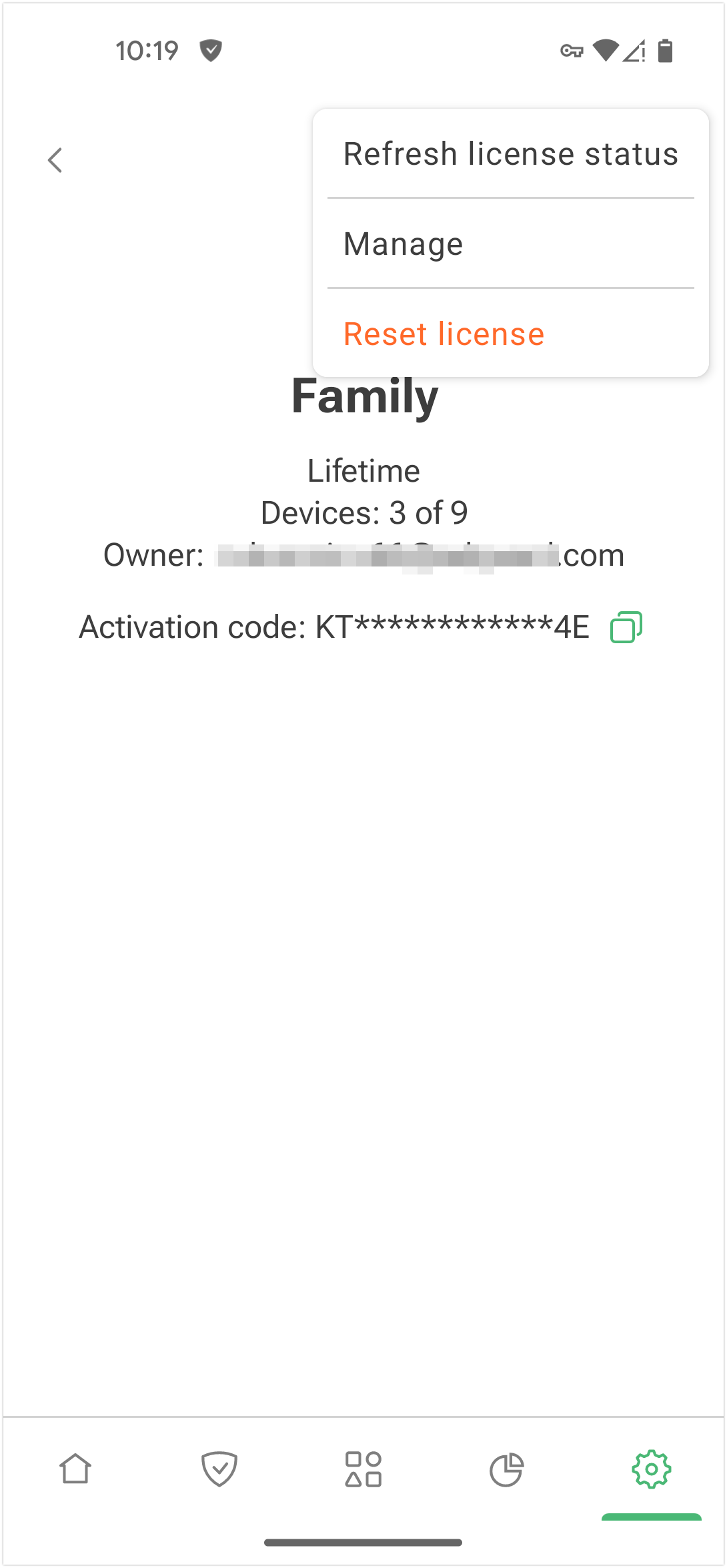
Assistance
Utilisez cette section si vous avez des questions ou suggestions concernant AdGuard pour Android. Nous vous recommandons de consulter FAQ ou cette base de connaissances avant de contacter le support.
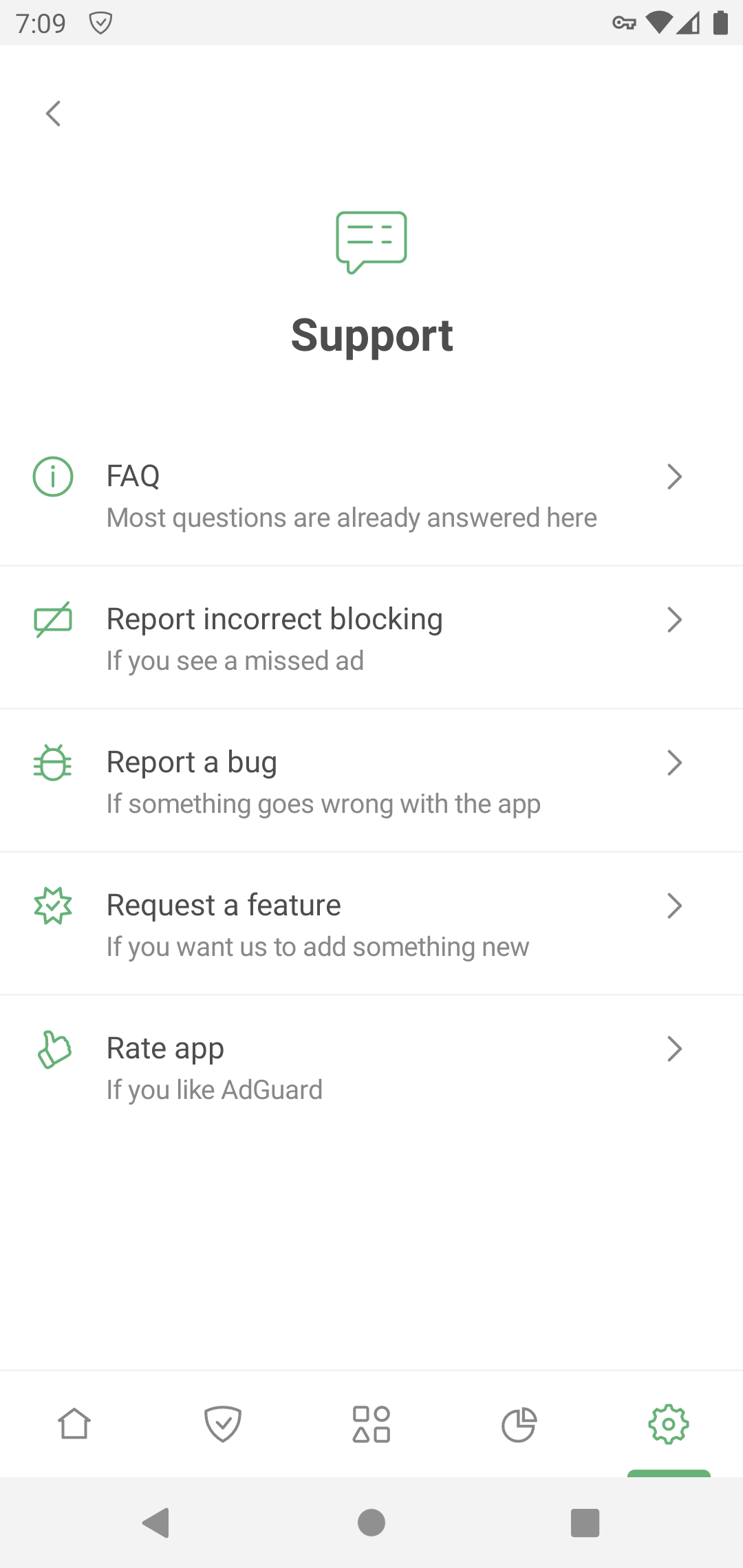
Si vous remarquez une publicité manquée, veuillez la signaler via Signaler un blocage incorrect.
Pour un comportement inattendu de l'application, sélectionnez Signaler un bug. Si possible, décrivez votre problème en détail et ajoutez les journaux de l'application. Comment décrire un problème
Pour vos suggestions, utilisez Demander une fonctionnalité.
GitHub est une méthode alternative pour signaler des bugs et suggérer de nouvelles fonctionnalités. Instructions et liens vers les dépôts